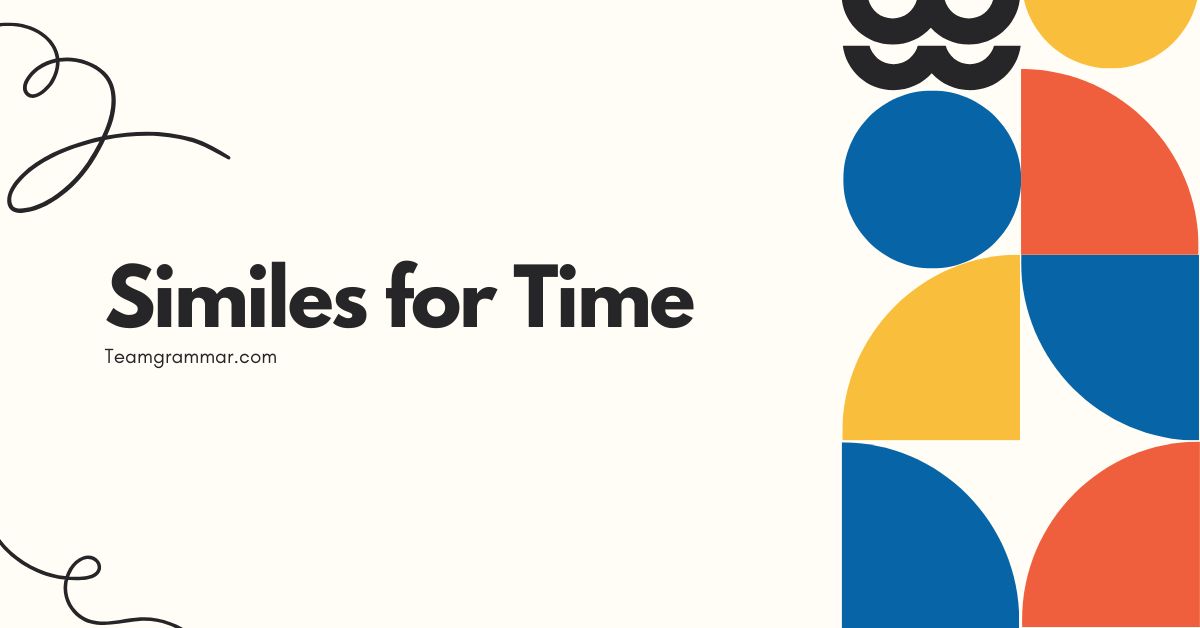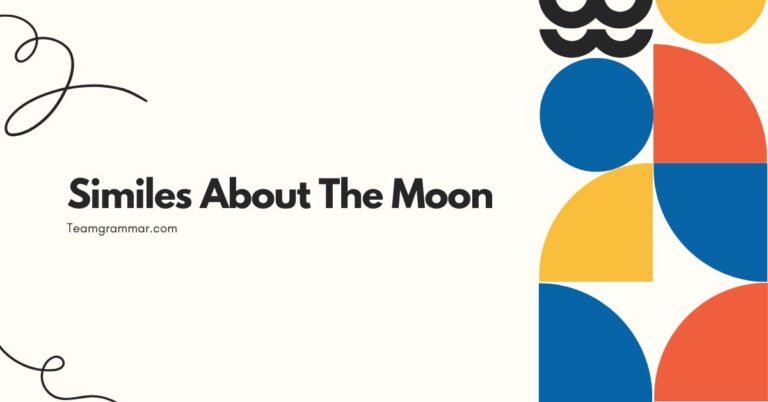49 Similes for Time: Mastering Figurative Language
Understanding how to use similes to describe time is crucial for adding vividness and depth to your writing and speech. Similes, by comparing time to other concepts, allow for a more nuanced and engaging portrayal of its passage, duration, or nature.
This article provides a comprehensive guide to similes for time, exploring their structure, types, and usage. Whether you’re a student, writer, or language enthusiast, this guide will equip you with the knowledge and skills to effectively use similes to enhance your expression and understanding of time.
Table of Contents
- Introduction
- Definition of Simile for Time
- Structural Breakdown of Similes for Time
- Types of Similes for Time
- Examples of Similes for Time
- Usage Rules for Similes for Time
- Common Mistakes When Using Similes for Time
- Practice Exercises
- Advanced Topics in Similes for Time
- Frequently Asked Questions (FAQ)
- Conclusion
Introduction
Time, an abstract concept, is often challenging to articulate precisely. Similes offer a powerful way to make time more relatable and understandable by comparing it to tangible things.
By employing similes, we can convey the sensation of time speeding up, slowing down, or remaining stagnant. This article delves into the effective use of similes to describe time.
We will explore the various types of similes used for time, provide numerous examples, discuss usage rules, and address common mistakes. This comprehensive guide will equip you with the tools to use similes effectively, adding richness and clarity to your descriptions of time.
The ability to craft effective similes is invaluable across various forms of communication. Whether you’re writing a novel, composing a poem, or simply engaging in everyday conversation, similes can elevate your language and make your message more impactful.
This article is designed for English language learners, writers, and anyone interested in expanding their understanding and application of figurative language. By mastering the art of using similes for time, you can express yourself with greater precision and creativity.
Definition of Simile for Time
A simile is a figure of speech that compares two unlike things using the words “like” or “as.” Similes are used to create a vivid image or to emphasize a particular quality by drawing a comparison between something familiar and something less so. In the context of time, a simile draws a comparison between the abstract concept of time and something more concrete or relatable.
Asimile for timespecifically compares the passage, duration, or nature of time to something else. This comparison helps to convey the feeling or experience of time in a more descriptive and impactful way.
For example, saying “Time flew by like a speeding bullet” uses a simile to convey the feeling that time passed very quickly. The function of similes for time is to make abstract concepts more understandable and relatable by drawing on the reader’s or listener’s experiences and associations with the object of comparison.
The contexts in which similes for time can be used are broad, spanning literature, poetry, everyday conversation, and professional writing. In literature, similes for time can be used to set the mood, develop characters, and advance the plot.
In poetry, they add depth and imagery to the expression of emotions and ideas. In everyday conversation, they make descriptions more engaging and expressive.
In professional writing, they can be used to explain complex concepts or to add a touch of creativity to otherwise dry material. The key is to choose similes that are appropriate for the context and that effectively convey the intended meaning.
Structural Breakdown of Similes for Time
Similes for time, like all similes, follow a basic structural pattern. This pattern consists of three key elements: the subject (time), the linking word (like or as), and the object of comparison.
Understanding this structure is essential for constructing effective and clear similes.
The first element is thesubject, which in this case is always some aspect of time. This could be the passage of time, a specific duration of time, or the feeling or experience of time.
For instance, in the simile “Time is like a river,” the subject is “time.”
The second element is the linking word, which is either “like” or “as.” These words establish the comparison between the subject and the object. In the example above, “like” is the linking word that connects time to the image of a river.
The third element is theobject of comparison, which is the concrete or relatable thing that time is being compared to. This object should have a quality or characteristic that the writer or speaker wants to associate with time.
In the example “Time is like a river,” the object of comparison is “a river,” which suggests the continuous and flowing nature of time.
Here’s a table summarizing the structural elements:
| Element | Description | Example |
|---|---|---|
| Subject | The aspect of time being described | Time |
| Linking Word | Connects the subject and object | Like / As |
| Object of Comparison | The concrete thing time is compared to | A river |
By understanding these structural elements, you can effectively create similes that capture the nuances of time and make your descriptions more vivid and engaging. It is important to select objects of comparison that resonate with your audience and effectively convey the intended meaning.
Types of Similes for Time
Similes for time can be categorized based on the aspect of time they emphasize. These categories include similes that describe the speed of time, the duration of time, the feeling of time, and the impact of time.
Understanding these categories can help you choose the most effective simile for your specific purpose.
Similes Describing the Speed of Time
These similes focus on how fast or slow time seems to be passing. They often use imagery of speed, such as vehicles or natural phenomena, to convey the sensation of time moving quickly or slowly.
For example, “Time flew by like a speeding bullet” emphasizes the rapid passage of time, while “Time crawled like a snail” emphasizes its slowness.
Similes Describing the Duration of Time
These similes focus on the length of time, emphasizing whether it feels short or long. They often use comparisons to events or experiences that are known to be brief or extended.
For example, “The meeting felt like an eternity” suggests that the meeting felt very long, while “The vacation was as short as a fleeting dream” suggests that it was very brief.
Similes Describing the Feeling of Time
These similes focus on the emotional or subjective experience of time. They often use comparisons to feelings, emotions, or states of mind to convey how time is perceived.
For example, “Time felt like a heavy burden” suggests that time was experienced as oppressive or difficult, while “Time felt like a gentle breeze” suggests that it was experienced as pleasant and easy.
Similes Describing the Impact of Time
These similes focus on the effects of time, such as aging, change, or decay. They often use comparisons to objects or processes that are affected by time to convey the impact of time.
For example, “Memories faded like old photographs” suggests that memories become less clear over time, while “His face was as lined as an ancient map” suggests that time has left its mark on his appearance.
Examples of Similes for Time
Here are some examples of similes for time, categorized by the aspect of time they describe. These examples illustrate the variety and creativity that can be used when crafting similes for time.
Examples Describing the Speed of Time
The following table presents examples focusing on the perceived speed of time, illustrating how quickly or slowly time can feel depending on the situation.
| Simile | Explanation |
|---|---|
| Time flew by like a speeding bullet. | Time passed very quickly. |
| Time crawled like a snail. | Time passed very slowly. |
| The seconds ticked by as slowly as dripping molasses. | Each second felt incredibly long. |
| The years vanished like smoke in the wind. | The years passed quickly and without a trace. |
| Time passed as swiftly as a hummingbird’s wings. | Time moved with great speed. |
| The hour went by like a blink of an eye. | The hour passed almost instantaneously. |
| Time moved as fast as a race car on a track. | Time accelerated rapidly. |
| The day went by as quick as a flash. | The day was very short. |
| Time stretched out like an endless highway. | Time felt long and drawn out. |
| The minutes dragged on like a wet weekend. | The minutes felt incredibly slow and unpleasant. |
| Time sped up like a roller coaster. | Time accelerated suddenly and dramatically. |
| The moments slipped away like grains of sand. | Time was fleeting and difficult to hold onto. |
| Time passed as leisurely as a Sunday morning. | Time moved at a relaxed and unhurried pace. |
| The years rolled by like tumbleweeds. | The years passed without significant events. |
| Time vanished as quickly as a dream upon waking. | Time disappeared almost instantly. |
| The seconds ticked by as loudly as a drumbeat. | Each second was noticeable and emphasized. |
| Time surged forward like a tidal wave. | Time moved powerfully and uncontrollably. |
| The day unfolded as slowly as a flower blooming. | The day progressed at a gradual and unhurried pace. |
| Time disappeared as fast as ice in summer. | Time melted away quickly. |
| The minutes crawled by like ants at a picnic. | The minutes were slow and tedious. |
Examples Describing the Duration of Time
The table below explores similes focusing on the perceived duration of time, highlighting how long or short a period can feel based on context.
| Simile | Explanation |
|---|---|
| The meeting felt like an eternity. | The meeting seemed to last a very long time. |
| The vacation was as short as a fleeting dream. | The vacation passed very quickly. |
| Waiting for the results felt like a lifetime. | The waiting period seemed incredibly long. |
| The lecture seemed as endless as the desert. | The lecture felt extremely long and monotonous. |
| The moment lasted an age. | The moment felt incredibly prolonged. |
| The summer break went by in a heartbeat. | The summer break passed very quickly. |
| The interview felt like a marathon. | The interview felt long and exhausting. |
| The wait was as long as a year without rain. | The wait felt incredibly prolonged and unbearable. |
| The class seemed like forever. | The class felt extremely long. |
| The time we spent together was as brief as a shooting star. | Our time together was very short and memorable. |
| The project deadline felt like a distant galaxy. | The deadline seemed far away and unattainable. |
| The period of silence felt like an ice age. | The silence seemed incredibly long and uncomfortable. |
| The concert flew by like a summer romance. | The concert passed very quickly and pleasantly. |
| The recovery felt as slow as watching paint dry. | The recovery process was tedious and time-consuming. |
| The conversation felt like wading through treacle. | The conversation was slow, difficult, and frustrating. |
| The preparation seemed like a climb up Mount Everest. | The preparation was long, arduous, and challenging. |
| The presentation was as brief as a commercial break. | The presentation was very short and concise. |
| The meeting stretched on like an elastic band. | The meeting felt prolonged and without end. |
| The transition phase felt like an uphill battle. | The transition felt long and difficult. |
| The development process felt like an odyssey. | The development was long, complex and adventurous. |
Examples Describing the Feeling of Time
This table focuses on similes describing the emotional or subjective experience of time, capturing how time can feel oppressive, liberating, or nostalgic.
| Simile | Explanation |
|---|---|
| Time felt like a heavy burden. | Time was experienced as oppressive and difficult. |
| Time felt like a gentle breeze. | Time was experienced as pleasant and easy. |
| Time was as precious as liquid gold. | Time was highly valued and cherished. |
| Time felt like a cruel master. | Time was experienced as harsh and unforgiving. |
| Time was as soothing as a lullaby. | Time was comforting and calming. |
| Time felt like a thief, stealing away youth. | Time was seen as taking away youth and vitality. |
| Time was as fleeting as happiness. | Time and happiness were perceived as temporary. |
| Time dragged like a chain when bored. | Time felt heavy and restrictive when bored. |
| Time was as empowering as a victory. | Time felt strong and liberating. |
| Time was as unpredictable as the weather. | Time was uncertain and changeable. |
| Time felt like a forgotten melody. | Time was nostalgic and vaguely remembered. |
| Time felt as light as a feather when carefree. | Time felt effortless and easy when carefree. |
| Time was as comforting as an old friend. | Time provided a sense of familiarity and solace. |
| Time felt like a slow poison when grieving. | Time was painful and destructive when grieving. |
| Time was as healing as a balm. | Time helped to soothe and recover from wounds. |
| Time felt like an open book when learning. | Time was full of opportunities for discovery and growth. |
| Time was as challenging as a labyrinth. | Time felt complex and confusing. |
| Time felt like a canvas when creating. | Time was a space for expression and artistry. |
| Time was as relentless as the tide. | Time was unstoppable and continuous. |
| Time felt like a warm embrace in good company. | Time felt comforting and pleasant when with loved ones. |
Examples Describing the Impact of Time
The following table presents examples that focus on the effects of time, such as aging, change, or decay, illustrating how time leaves its mark.
| Simile | Explanation |
|---|---|
| Memories faded like old photographs. | Memories became less clear over time. |
| His face was as lined as an ancient map. | Time had left its mark on his appearance. |
| The building crumbled like a sandcastle. | The building deteriorated over time. |
| Their love withered like a forgotten flower. | Their love faded away over time. |
| The tradition eroded like a coastline. | The tradition gradually disappeared over time. |
| Her voice was as cracked as antique pottery. | Her voice showed signs of aging. |
| The secret was as fragile as old paper. | The secret was easily broken or revealed over time. |
| His spirit was as resilient as an ancient tree. | His spirit remained strong despite the passage of time. |
| The antique car was as preserved as a museum piece. | The car was well-maintained and showed little sign of aging. |
| The truth was as timeless as the stars. | The truth remained constant and unchanged over time. |
| Her wisdom was as deep as an old well. | Her wisdom had accumulated over many years. |
| The landscape was as scarred as a battlefield. | The landscape showed the effects of time and conflict. |
| The city’s history was as layered as a sedimentary rock. | The city had many historical periods and influences. |
| His legacy was as enduring as a monument. | His legacy would last for many years. |
| The photograph was as yellowed as parchment. | The photograph had aged and discolored over time. |
| The artifact was as delicate as a butterfly’s wing. | The artifact was fragile and easily damaged by time. |
| The document was as faded as an ancient manuscript. | The document had lost its clarity over time. |
| The skill was as rusty as an unused tool. | The skill had deteriorated due to lack of practice. |
| The relationship was as strong as an old oak tree. | The relationship had grown stronger over time. |
| The story was as worn as a favorite book. | The story had been told many times and showed signs of wear. |
Usage Rules for Similes for Time
Using similes effectively requires adherence to certain rules to ensure clarity and impact. These rules involve selecting appropriate objects of comparison, maintaining logical consistency, and avoiding clichés.
By following these guidelines, you can create similes that enhance your writing and communication.
Select Appropriate Objects of Comparison:The object of comparison should be something that your audience is familiar with and that effectively conveys the intended meaning. Choose objects that have clear associations with the aspect of time you are describing.
For example, if you want to convey the feeling that time is passing slowly, comparing it to a snail or molasses would be more effective than comparing it to a race car.
Maintain Logical Consistency:The comparison should be logical and make sense in the context. Avoid comparisons that are confusing or contradictory.
For example, saying “Time is like a square circle” would be illogical and ineffective because a square circle is an impossibility.
Avoid Clichés:Clichés are overused similes that have lost their impact. While they may be easy to use, they often fail to create a vivid image or convey a unique perspective.
Instead of relying on clichés, strive to create original and imaginative similes that capture the essence of time in a fresh and engaging way. For example, instead of saying “Time flies,” try “Time flew by like a flock of birds taking flight.”
Consider the Context:The choice of simile should be appropriate for the context in which it is used. Consider the tone, audience, and purpose of your writing or speaking.
A simile that is effective in a poem may not be appropriate in a business report. Choose similes that align with the overall style and message of your communication.
By following these usage rules, you can ensure that your similes for time are clear, effective, and impactful, enhancing your ability to describe and convey the nuances of time.
Common Mistakes When Using Similes for Time
Even with a solid understanding of similes, it’s easy to make mistakes. Here are some common errors to avoid when using similes for time, along with corrections to illustrate proper usage.
Using Inaccurate Comparisons: This occurs when the object of comparison does not logically relate to the aspect of time being described. For example:
- Incorrect: Time is like a refrigerator.
- Correct: Time is like a river.
The corrected example uses “river,” which evokes the continuous flow and passage of time, making it a more appropriate comparison.
Using Confusing Comparisons:A simile should clarify, not confuse. If the comparison is too abstract or unfamiliar, it will not be effective.
For example:
- Incorrect: Time is like a quantum entanglement.
- Correct: Time is like a winding road.
The corrected example uses “winding road,” which is a more accessible and understandable image, conveying the idea that time can be unpredictable and have many twists and turns.
Overusing Clichés: Relying on overused similes diminishes the impact of your writing. For example:
- Incorrect: Time flies.
- Correct: Time flew by like a speeding train.
The corrected example adds specificity and imagery, making the simile more vivid and engaging.
Ignoring Context: A simile that is appropriate in one context may not be appropriate in another. For example:
- Incorrect (in a formal setting): Time is like, you know, whatever.
- Correct (in a formal setting): Time is as valuable as any resource.
The corrected example uses more formal language and conveys a more serious tone, making it suitable for a professional setting.
Here’s a table summarizing common mistakes and their corrections:
| Mistake | Incorrect Example | Correct Example |
|---|---|---|
| Inaccurate Comparison | Time is like a shoe. | Time is like a fleeting shadow. |
| Confusing Comparison | Time is like a fractal dimension. | Time is like a never-ending story. |
| Overused Cliché | Time heals all wounds. | Time heals wounds like a gentle balm. |
| Ignoring Context | Time is, like, totally awesome! | Time is a critical factor in our success. |
By avoiding these common mistakes, you can ensure that your similes for time are clear, effective, and appropriate for the context in which they are used.
Practice Exercises
Test your understanding of similes for time with these practice exercises. Each exercise includes a question and a space to provide your answer.
Exercise 1: Identifying Similes
Identify the similes in the following sentences:
| Question | Your Answer |
|---|---|
| 1. Time is as valuable as money. | |
| 2. The years vanished like smoke. | |
| 3. Waiting felt like an eternity. | |
| 4. Time passed slowly. | |
| 5. The moment was as brief as a dream. | |
| 6. Time is precious. | |
| 7. Time felt like a burden. | |
| 8. The lesson felt like a long journey. | |
| 9. Time is relentless. | |
| 10. The project felt like the time of my life. |
Exercise 2: Completing Similes
Complete the following similes with an appropriate comparison:
| Question | Your Answer |
|---|---|
| 1. Time flew by like ____. | |
| 2. Time crawled like ____. | |
| 3. Time stretched out like ____. | |
| 4. Time was as precious as ____. | |
| 5. Time felt like ____. | |
| 6. Time is as unpredictable as ____. | |
| 7. Time heals like ____. | |
| 8. Time can be as cold as ____. | |
| 9. Time is as constant as ____. | |
| 10. Time is as deep as ____. |
Exercise 3: Creating Similes
Create your own similes for time based on the following prompts:
| Question | Your Answer |
|---|---|
| 1. Describe the feeling of time passing quickly. | |
| 2. Describe the feeling of waiting for something important. | |
| 3. Describe the impact of time on memories. | |
| 4. Describe how time feels when you are bored. | |
| 5. Describe how time feels when you are having fun. | |
| 6. Describe how time feels when you are in love. | |
| 7. Describe how time feels when you are stressed. | |
| 8. Describe how time feels when you are relaxed. | |
| 9. Describe how time feels when you are learning something new. | |
| 10. Describe how time feels when you are creating something. |
Answer Key
Exercise 1: Identifying Similes
- Time is as valuable as money.
- The years vanished like smoke.
- Waiting felt like an eternity.
- (No simile)
- The moment was as brief as a dream.
- (No simile)
- Time felt like a burden.
- The lesson felt like a long journey.
- (No simile)
- The project felt like the time of my life.
Exercise 2: Completing Similes (Example Answers)
- Time flew by like a speeding train.
- Time crawled like a snail in molasses.
- Time stretched out like an endless highway.
- Time was as precious as liquid gold.
- Time felt like a gentle breeze.
- Time is as unpredictable as the weather.
- Time heals like a gentle balm.
- Time can be as cold as a winter’s night.
- Time is as constant as the rising sun.
- Time is as deep as the ocean.
Exercise 3: Creating Similes (Example Answers)
- Time passing quickly felt like flipping through the pages of a captivating novel.
- Waiting for something important felt like an eternity trapped in a small room.
- The impact of time on memories is like faded photographs, losing their clarity over the years.
- Time feels when you are bored like wading through thick mud, slow and laborious.
- Time feels when you are having fun like a rollercoaster, fast and exhilarating.
- Time feels when you are in love like a harmonious melody, sweet and unforgettable.
- Time feels when you are stressed like a tangled knot, difficult to unravel.
- Time feels when you are relaxed like floating on a calm sea, peaceful and serene.
- Time feels when you are learning something new like opening a door to a new world, full of possibilities.
- Time feels when you are creating something like molding clay, shaping and transforming.
Advanced Topics in Similes for Time
For advanced learners, exploring more complex aspects of similes for time can further enhance their understanding and usage. These topics include extended similes, metaphorical similes, and cultural variations in similes for time.
Extended Similes
An extended simile is a simile that is developed over several sentences or even paragraphs. Instead of making a brief comparison, an extended simile explores the similarities between the subject and object in greater detail, creating a more vivid and nuanced image.
For example, instead of saying “Time is like a river,” an extended simile might say:
“Time is like a river, constantly flowing and changing. It starts as a small stream, gathering momentum and strength as it moves forward.
Along its course, it encounters obstacles and challenges, but it always finds a way to keep moving. Sometimes it flows smoothly and peacefully, other times it rages and storms.
And eventually, it reaches the ocean, where it merges with something larger than itself.”
Metaphorical Similes
A metaphorical simile is a simile that uses a metaphor as the object of comparison. This creates a double layer of figurative language, adding depth and complexity to the comparison.
For example, instead of saying “Time is like a clock,” a metaphorical simile might say:
“Time is like a ticking bomb, constantly counting down and threatening to explode.”
In this example, “ticking bomb” is a metaphor for a stressful or dangerous situation, which is then used as the object of comparison in the simile.
Cultural Variations in Similes for Time
Different cultures may have different ways of perceiving and describing time. This can be reflected in the similes that are used to describe time in different languages and cultures.
For example, a culture that values punctuality may have similes that emphasize the importance of being on time, while a culture that is more relaxed about time may have similes that emphasize the fluidity and flexibility of time.
Understanding these advanced topics can help you use similes for time in a more sophisticated and nuanced way, enhancing your ability to express complex ideas and emotions.
Frequently Asked Questions (FAQ)
Here are some frequently asked questions about similes for time, along with detailed answers to help clarify any confusion.
- What is the difference between a simile and a metaphor?
- How do I choose the best object of comparison for a simile about time?
- Can a simile be too long or too complex?
- Are there any similes for time that should be avoided?
- How can I make my similes for time more original and creative?
- Can similes for time be used in formal writing?
-
What are some examples of similes for time used in famous literature?
- How do cultural differences affect the understanding and use of similes for time?
- Is it okay to mix metaphors and similes when describing time?
- How can similes for time be used in persuasive writing?
A simile compares two things using “like” or “as,” while a metaphor directly equates two things without using these words. For example, “Time is like a river” is a simile, while “Time is a river” is a metaphor.
Similes are generally considered less direct and forceful than metaphors.
Consider the specific aspect of time you want to describe (speed, duration, feeling, impact) and choose an object that has clear associations with that aspect. Also, consider your audience and choose an object that they will be familiar with and able to relate to.
Yes, a simile can be too long or too complex if it becomes confusing or detracts from the main point. Aim for clarity and conciseness.
If you want to explore the comparison in greater detail, consider using an extended simile, but make sure it remains focused and easy to follow.
Avoid clichés, which are overused similes that have lost their impact. Also, avoid similes that are illogical, confusing, or inappropriate for the context.
Think outside the box and look for unique and unexpected comparisons. Draw on your own experiences and observations to create similes that are personal and meaningful.
Experiment with different types of imagery and figurative language.
Yes, similes for time can be used in formal writing, but they should be used sparingly and with careful consideration of the tone and audience. Choose similes that are appropriate for the context and that enhance the clarity and impact of your writing.
In Shakespeare’s “Hamlet,” time is often portrayed metaphorically, but a simile-like construction appears when Hamlet speaks of “the slings and arrows of outrageous fortune,” suggesting time (and fortune) can wound. In Proust’s “In Search of Lost Time,” similes abound to describe the subjective experience of time, such as comparing memories to objects recovered from the depths of one’s mind.
Different cultures perceive time differently—some view it as linear, others as cyclical. These perceptions influence the similes used.
For instance, in some cultures, time might be compared to a flowing river (linear), while in others, it might be likened to a turning wheel (cyclical).
While it’s generally advisable to maintain consistency, skilled writers can mix metaphors and similes effectively to create a richer texture. However, ensure that the combination doesn’t lead to confusion or mixed imagery that detracts from the overall impact.
Similes can make abstract ideas more relatable and emotionally resonant. For example, “Wasting time is like throwing away money” can be a persuasive argument for better time management, appealing to the reader’s sense of value and loss.
Conclusion
Similes for time are powerful tools for enhancing your writing and communication. By comparing time to concrete and relatable concepts, you can convey its nuances and impact in a vivid and engaging way.
Understanding the structure, types, and usage rules of similes for time will enable you to craft effective and original comparisons that resonate with your audience.
Throughout this article, we’ve explored the definition of similes for time, their structural breakdown, various types, and numerous examples. We’ve also discussed usage rules, common mistakes to avoid, and practice exercises to hone your skills.
Additionally, we’ve touched on advanced topics such as extended similes, metaphorical similes, and cultural variations, providing a comprehensive understanding of this figurative language technique.
By mastering the art of using similes for time, you can add depth, clarity, and creativity to your descriptions, making your writing more compelling and memorable. Whether you’re a student, writer, or language enthusiast, the knowledge and skills gained from this guide will serve you well in expressing the multifaceted nature of time.







